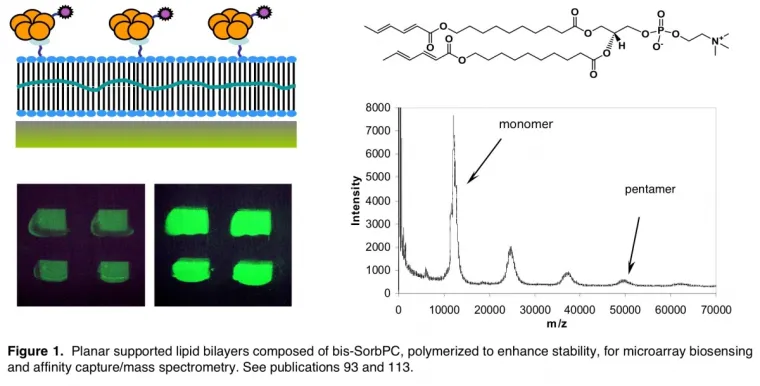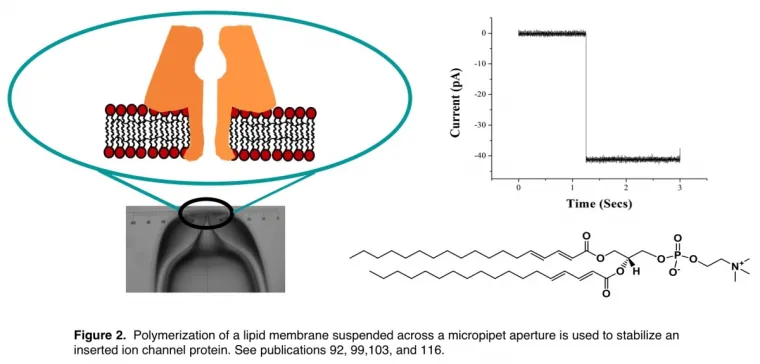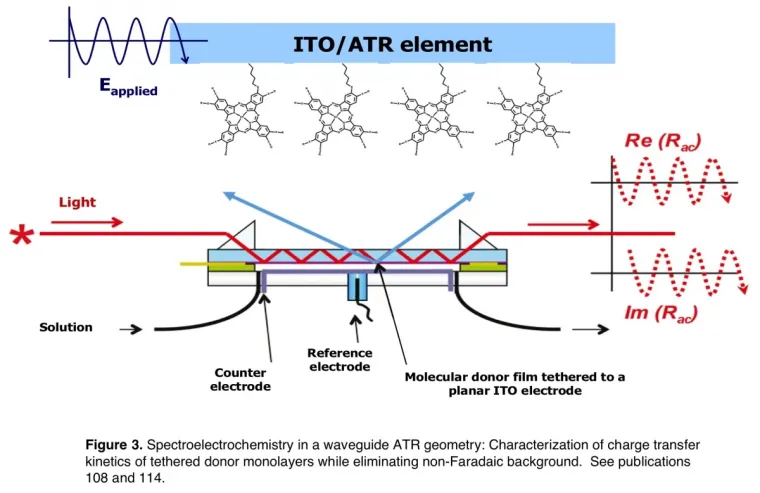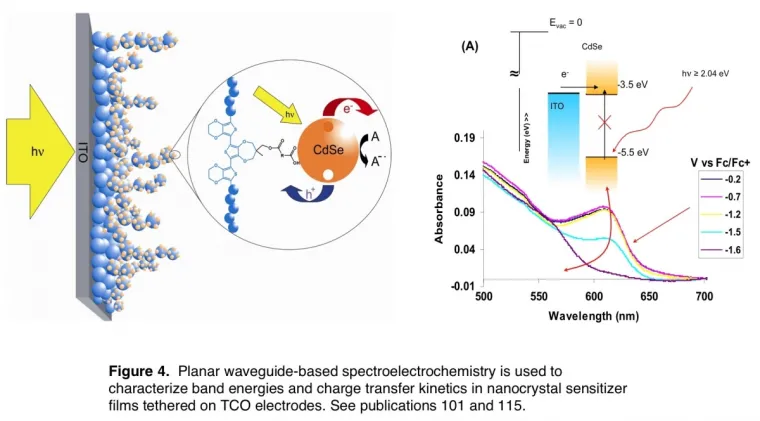Professor Emeritus - Retired
Degrees and Appointments
- B.S., 1981, University of Maryland (Biochemistry)
- Ph.D., 1986, Duke University (Analytical Chemistry)
- Postdoctoral Fellow, 1989-1991, Duke University (Biomedical Engineering)
Field of Study: Analytical Chemistry
Awards and Honors
- Research Fellowship, NSF-Engineering Research Center for Emerging Cardiovascular Technologies, Duke University, 1989-90
- Associated Western Universities Faculty Fellowship, 1994-95
- Galileo Circle Fellow, College of Science, University of Arizona, 2017
Research Specialties: Bioanalytical, Biophysics, Energy Science, Instrument Development, Materials and Polymer Chemistry, Protein and Membrane Biochemistry, Spectroscopy/Molecular Structure, Surface and Solid State
Research
The multidisciplinary research activities of our group are organized around several overlapping themes: new biointerfaces and thin film biomaterials for molecular device technologies such as chemical and biochemical sensing, new supramolecular assemblies for solar capture and energy conversion, and the development of novel surface spectroscopies and molecular devices based on optical waveguides. Some current projects are:
1. Creation of novel protein and proteo-lipid supramolecular assemblies for biosensing and affinity capture (e.g., Figures 1 and 2). Our fundamental studies of these assemblies seek to elucidate relationships between their structure and biofunction, ultimately leading to creation of advanced bioanalytical technologies.
2. Development of novel waveguide-based, spectroscopic techniques for characterization of surfaces, thin film materials, and interfaces (e.g., Figures 3-4). Spectroelectrochemistry using a planar waveguide geometry has been a focus of much of our recent work.
3. Characterization of the structure and charge transfer properties of heterojunctions between transparent conducting oxide (TCO) electrodes and organic donor films in organic photovoltaic devices (OPVs). These fundamental studies should ultimately lead to enhanced OPV efficiencies (e.g., Figure 3).
4. Development and characterization of thin materials based on supramolecular assemblies of nanocrystals. These materials are being designed as photoelectrochemical catalysts for hydrogen production and as sensitizers in hybrid solar cells (e.g., Figure 4).
A variety of modern analysis tools are used in these projects, including optical waveguide absorbance spectroscopy, total internal reflection fluorescence spectroscopy, transient absorbance spectroscopy, waveguide-enhanced spectroelectrochemistry, atomic force microscopy, and vacuum surface analysis. methods. Some of these techniques are unique to our laboratory, and are undergoing continuing development, which is facilitated by collaborations with researchers in the Chemistry and Biochemistry Department, other departments on this campus, and other universities.




Boying Liang, Yue Ju, James Joubert, Erin Kaleta, Rodrigo Lopez, Ian Jones, Henry K. Hall, Jr., Saliya Ratnayaka, Vicki Wysocki, and S. Scott Saavedra, Anal. Bioanal. Chem. 2015, 407, 2777-2789. MALDI-TOF MS label-free detection and identification of bacterial toxins captured by membrane receptors in polymerized lipid bilayers.
Hsiao-Chu Lin, Gordon A. MacDonald, Yanrong Shi, Nathan W. Polaske, Dominic V. McGrath, Seth R. Marder, Neal R. Armstrong, Erin L. Ratcliff, and S. Scott Saavedra, J. Phys. Chem. C, 2015, 119, 10304–10313. Influence of Molecular Orientation on Charge-Transfer Processes at Phthalocyanine/Metal Oxide Interfaces and Relationship to Organic Photovoltaic Performance.
Ramanan Ehamparam, Nicholas Pavlopoulos, Michael W. Liao, Lawrence J. Hill, Neal R. Armstrong, Jeffrey Pyun, and S. Scott Saavedra, ACS Nano, 2015, 9, 8786–8800. Band Edge Energetics of Heterostructured Nanorods: Photoemission Spectroscopy and Waveguide Spectroelectrochemistry of Au-Tipped CdSe Nanorod Monolayers.
Elyssia Gallagher, Seid Adem, Christopher Baker, Saliya Ratnayaka, Ian Jones, Henry K. Hall, Jr., S. Scott Saavedra, and Craig A. Aspinwall, J. Chromatogr. A 2015, 1385, 28-34. Highly stabilized, polymer-lipid membranes prepared on silica microparticles as novel stationary phases for capillary chromatography.
Leonard Bright, Christopher Baker, Robert Bränström, S. Scott Saavedra, Craig Aspinwall, ACS Biomater. Sci. Eng., 2015, 1, 955–963. Methacrylate Polymer Scaffolding Enhances the Stability of Suspended Lipid Bilayers for Ion Channel Recordings and Biosensor Development.
Kristina S. Orosz, Ian W. Jones, John P. Keogh, Christopher M. Smith, Kaitlyn R. Griffin, Juhua Xu, Troy J. Comi, H. K. Hall, Jr. and S. Scott Saavedra, Langmuir, 2016, 32, 1577–1584. Photopolymerization of Dienoyl Lipids Creates Planar Supported Poly(lipid) Membranes with Retained Fluidity.
Kai-Lin Ou, Ramanan Ehamparam, Gordon MacDonald, Tobias Stubhan, Wu Xin, R. Clayton Shallcross, Robin Richards, Christoph Brabec, S. Scott Saavedra, and Neal Armstrong, ACS Appl. Mater. Interfaces, 2016, 8, 19787–19798. Characterization of ZnO Interlayers for Organic Solar Cells: Correlation of Electrochemical Properties with Thin Film Morphology and Device Performance.
Yilong Zheng, Anthony J. Giordano, R. Clayton Shallcross, Sean R. Fleming, Stephen Barlow, Neal R. Armstrong, Seth R. Marder, and S. Scott Saavedra, J. Phys. Chem. C, 2016, 120, 20040–20048. Surface Modification of Indium-Tin Oxide with Functionalized Perylene Diimides: Characterization of Orientation, Charge-Transfer Kinetics and Electronic Structure.
Yilong Zheng, Fadi M. Jradi, Timothy C. Parker, Stephen Barlow, Seth R. Marder, and S. Scott Saavedra, ACS Appl. Mater. Interfaces, 2016, 8, 34089–34097. Influence of Molecular Aggregation on Electron Transfer at the Perylene Dimide/Indium-Tin Oxide Interface.
Marvin J. Slepian, Jawaad Sheriff, Marcus Hutchinson, Phat Tran, Naing Bajaj, Joe G.N. Garcia, S. Scott Saavedra, and Danny Bluestein, J. Biomechanics, 2017, 50, 20-25. Shear-Mediated Platelet Activation in the Free Flow: Perspectives on the Emerging Spectrum of Cell Mechanobiological Mechanisms Mediating Cardiovascular Implant Thrombosis.
Mark T. Agasid, Troy C. Comi, S. Scott Saavedra, and Craig A. Aspinwall, Anal. Chem., 2017, 89, 1315–1322. Enhanced Temporal Resolution with Ion Channel-Functionalized Sensors Using a Conductance-Based Measurement Protocol.
Yilong Zheng and S. Scott Saavedra, Anal. Sci., 2017, 33, 427-433. Characterization of Charge Transfer Kinetics at Organic/Electrode Interfaces Using Potential-Modulated Attenuated Total Reflectance (PM-ATR) Spectroscopy.
R. Clayton Shallcross, Yilong Zheng, S. Scott Saavedra and Neal R. Armstrong, J. Amer. Chem. Soc., 2017, 139, 4866–4878. Determining Band-Edge Energies and Morphology-Dependent Stability of Formamidinium Lead Perovskite Films Using Spectroelectrochemistry and Photoelectron Spectroscopy.
Ramanan Ehamparam, Luis E. Oquendo, Michael W. Liao, Ambjorn Karl Brynnel,& Kai-Lin Ou, Neal R. Armstrong, Dominic V. McGrath, and S. Scott Saavedra, ACS Appl. Mater. Interfaces, 2017, 9, 29213–29223. Axially Bound Ruthenium Phthalocyanine Monolayers on Indium Tin Oxide: Structure, Energetics and Charge Transfer Properties.
Mark T. Agasid, Xuemin Wang, Yiding Huang, Colleen M. Janczak, Robert Bränström, S. Scott Saavedra, Craig A. Aspinwall,Protein Expression and Purification, 2018,146, 61-68. Expression, purification, and electrophysiological characterization of a recombinant, fluorescent Kir6.2 in mammalian cells.
Guancao Yang, Chuanli Wu, Xiaojun Luo, Xiaoyan Liu, Yuan Gao, Ping Wu, Chenxin Cai, and S. Scott Saavedra, J. Phys. Chem. C, 2018, 122, 6483–6492. Exploring the Emissive States of Heteroatom-Doped Graphene Quantum Dots.
Luis Oquendo, Ramanan Ehamparam, Neal Armstrong, S. Scott Saavedra, and Dominic McGrath, J. Phys. Chem. C, 2019, 123, 6970−6980. Zinc Phthalocyanine-Phosphonic Acid Monolayers on ITO: Influence of Molecular Orientation, Aggregation, and Tunneling Distance on Charge-Transfer Kinetics.
Malithi Fonseka, Boying Liang, Kristina Orosz, Ian Jones, H. K. Hall, Jr., Hamish Christie, Craig Aspinwall, and S. Scott Saavedra, Langmuir, 2019, in press. Nanodomain formation in planar supported lipid bilayers composed of fluid and polymerized dienoyl lipids.






